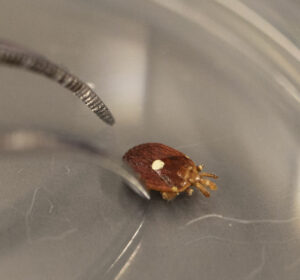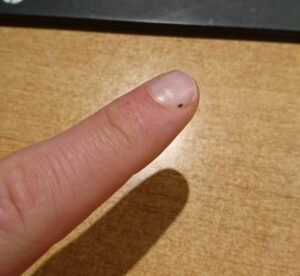
Alpha-Gal Syndrome, or AGS, is a recently identified tick-borne disease that triggers an allergy to red meat and other products made from mammals, including cheese, gelatin, and medications like heparin.
Since its discovery in 2009, cases in the United States alone have risen from 24 to >40,000 people, owing to the geographic spread of the tick populations and the fact that the allergy has been given a name. Unfortunately, diagnostics and treatment are lagging behind other vector-borne diseases like malaria.
Scott Commins, MD, PHD, an associate professor of medicine and pediatrics in the Division of Rheumatology, Allergy, and Immunology, and Ross Boyce, MD, MSc, an assistant professor of medicine and epidemiology in the Division of Infectious Diseases, are leveraging their own specialties to tackle AGS, and other tick-borne diseases, together.
“I think that the discovery of Alpha-Gal Syndrome, and an awareness of other tick-borne diseases, has made people realize that a single tick bite can have profound ramifications on your life because of the influence it has on the immune system,” said Commins. “It’s not something to take lightly, and prevention, diagnosis, and management of these diseases takes collaboration between immunologists, infectious disease experts, and more.”
Commins was on the research team at the University of Virginia that connected the red meat allergy to AGS back in 2007. The team learned that when a lone star tick feeds on the blood of a deer, pig, cow, or lamb, it picks up the alpha-gal sugar molecule during that bloodmeal, which is not present in human cells.

When that tick bites a human, its saliva creates a danger signal, causing alarms to go off in the immune system and initiating the allergic response to alpha-gal. The immune system then treats anything that contains that molecule as a threat, causing rashes, diarrhea, nausea, vomiting, and, in severe cases, anaphylaxis akin to a severe peanut allergy.
But understanding the immunological side of AGS is only half the battle.
Boyce has been looking at the syndrome from the aspect of infectious disease to understand where ticks are and what diseases they are transmitting. Typically, ticks are found in densely vegetated areas like farmland, overgrown lawns, and hiking trails.
Due to these factors, those who live in rural and underserved regions of the southeastern United States, as well as hunters and outdoor recreation enthusiasts, are particularly vulnerable to their growing numbers and the diseases they carry. However, with rapid development into previously wooded areas, ticks are frequently encountered in many suburban neighborhoods and parks.
“You’re not only just seeing a patient,” said Boyce. “You’ve also got to think about the setting where this person was potentially exposed, what ticks might it have been, and if they have deer in their backyard. Those factors all impact the spread of ticks and tick-borne diseases.”
A Collaboration is Born

As an infectious disease physician, Boyce sees many patients who have been bitten by a tick and have lingering symptoms. They may have initially been infected with bacterial tick-borne diseases like Rocky Mountain Spotted Fever or ehrlichiosis that typically cause fever, headache, and body aches, but these conditions usually resolve with appropriate treatment.
But some still have symptoms after their initial infection has been treated. Unfortunately, some patients with these bacterial infections are also impacted by AGS when they are bitten by a tick. As a result, Boyce has referred many patients over to Commins for further evaluation of their allergy, which has given him a chance to learn more about AGS along the way.
“I’ve probably sent dozens of patients his way,” said Boyce. “And in the process of that, he’s helped me learn how to help folks until they can get to see him. So, I don’t want to say I’m an expert in alpha gal management, but we are acting as each other’s referral centers.”
Creativity Hub and a Center on the Horizon
Together, they are working to accelerate the generation of fundamental knowledge and to improve patient care through treatment and outreach. Commins has been giving “alpha-gal starter kits” to newly diagnosed patients. The brown duffel bags are filled with permethrin-treated socks, lint rollers, and tick tweezers to ensure that the ticks are removed as successfully as possible.
Two and a half years ago, Boyce received funding from the Office of the Vice Chancellor for Research at UNC for the Creativity Hub awards, which has been a real boost to their efforts. He has formed the Vector-Borne Disease: Epidemiology, Ecology & Response (VEER) Hub, a multidisciplinary group of academic investigators and public health practitioners from partner universities, military installations, and health care agencies.
“The whole idea is to break down silos and educate the public. As a doctor, I’m at the end of that pathway — a person getting a tick-borne illness. That is why we need people like geographers, entomologists, immunologists, and veterinarians to be involved in this. In a lot of ways, they’re more key than I am because there’s so little known about how to control these ticks.”
Boyce and Commins are also part of the recently-announced CDC Southeastern Center of Excellence in Vector Borne Diseases, which aims to accelerate public health research on many of these topics. Alpha-gal is one of the primary research areas of the Center.
Down the road, Commins and Boyce hope to build a specialized center where they can really care for more patients that have tick-borne diseases. For the time being, Commins and Boyce are working on a few research projects.
Research In Progress

Interestingly, the reaction from one tick bite is not strong enough to embed itself into the “memory” of the immune system. As a result, the allergy slowly goes away after a couple of years and does not become a permanent response. That is, unless you are bitten repeatedly by ticks with the alpha-gal molecule.
In light of this information, Commins has been working with mouse models to create a treatment that would prevent a permanent immune response from occurring. Essentially, he exposes the models to low doses of tick saliva. Over time, the dosage will be slowly increased to build up an immune tolerance to the saliva.
“Our hope is that that we could prevent additional bites from re-immunizing that response by desensitizing them to the tick saliva,” said Commins. “It’s a very similar paradigm for treating anaphylaxis after a bee sting. There’s no way to prevent that initial bite or sting, but we just want to mitigate the risk for future stings.”
He is also working on two short term research projects. The first project involves taking blood from newly-diagnosed patients to see if he can understand what is happening on a cellular level. More specifically, he wants to find out what caused the allergic switch to get flipped and how he can interfere with that process to stop it from coming to fruition.
He is also working with a company that genetically edits pigs so that they do not produce the Alpha-Gal molecule. Not only could this be a new source of pork for patients, it could provide a safe alternative for mammal-derived medical products like heart valves and vaccines.
– Written by Kendall Daniels